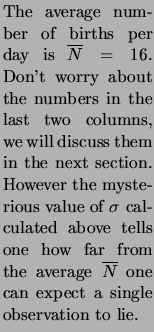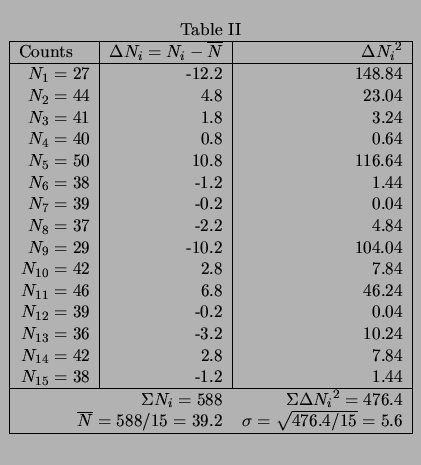Statistical theory predicts that if one records the counts of  different
experiments:
different
experiments:
 and one calculates the average of
these
and one calculates the average of
these
 the counts will distribute themselves
around the average value. Counts close to the average will occur frequently,
counts very different from the average will occur infrequently.
the counts will distribute themselves
around the average value. Counts close to the average will occur frequently,
counts very different from the average will occur infrequently.
If one makes a histogram of the number of times a certain count appears one
finds a bell shaped curve called a ``Gaussian distribution'' centered on
the average.
The histogram below looks a lot better than the ones you have seen above;
this is so because it shows the distribution of many more observations.
![\includegraphics[height=6.5cm]{figs/l104/fnc1a-3.eps}](img482.png)
Fig 3: A Gaussian distribution
The histogram shows that counts of about 100 are most frequent,
and that counts
of 70, or 130 are much less likely to occur; we can think of the
``width'' of the curve i.e. the range of the counts that occur most frequently
is about 20.
THE STANDARD DEVIATION
Statistical theory predicts that the width of the curve, the
``standard deviation'' of the distribution is defined as:
The standard deviation  is a measure of how wide the curve is;
about 1/3
of the counts will lie outside the interval
is a measure of how wide the curve is;
about 1/3
of the counts will lie outside the interval
 to
to
 .
.
Only about 1/20
of the counts will lie outside the interval
 to
to
 .
The value of
.
The value of  is calculated automatically by your computer, so you do
not really have to worry about it.
However here goes the formula, you may skip this if you
wish.
is calculated automatically by your computer, so you do
not really have to worry about it.
However here goes the formula, you may skip this if you
wish.



![$\textstyle \parbox{0.46\linewidth}{
\includegraphics[height=4.8cm]{figs/l104/fnc1a-1.eps} \\
Fig. 1: Distribution of Monday births
}$](img474.png)


![\includegraphics[height=6.cm]{figs/l104/fnc1a-2.eps}](img477.png)
![\includegraphics[height=6.5cm]{figs/l104/fnc1a-3.eps}](img482.png)

![\includegraphics[height=5.2cm]{figs/l104/fnc1a-4.eps}](img494.png)

